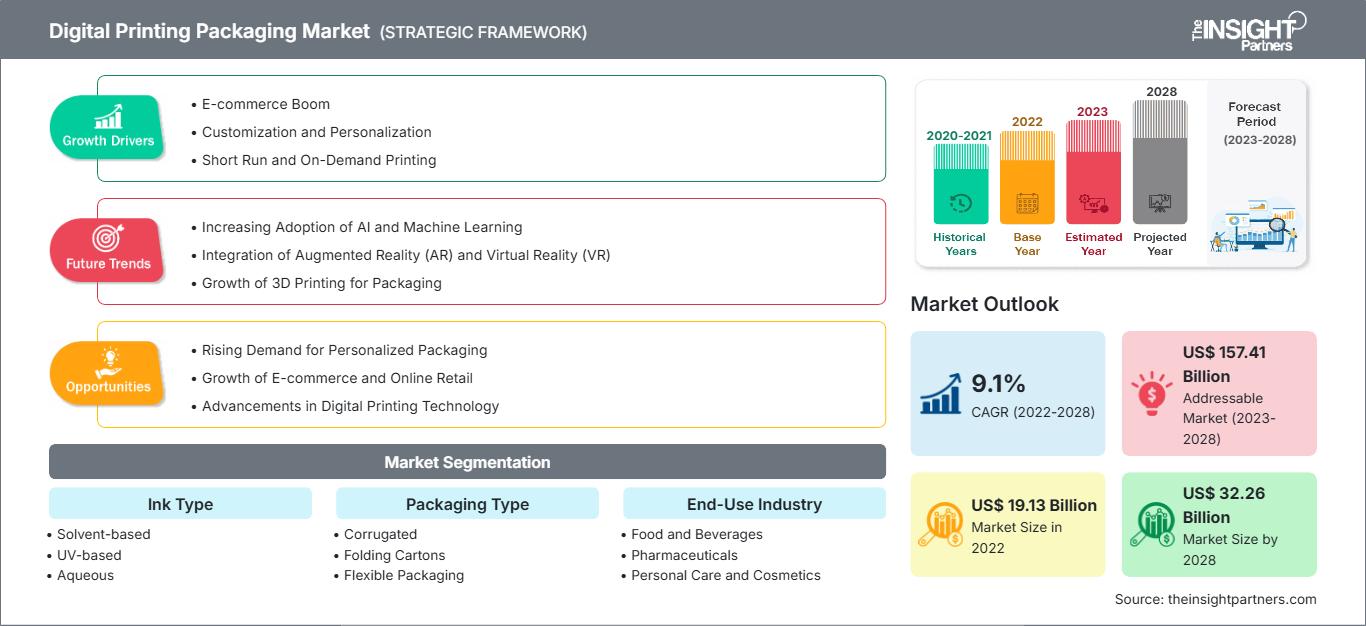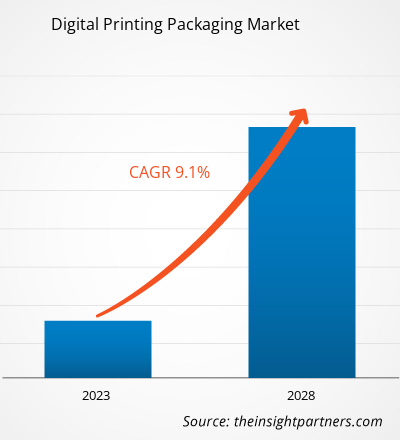预计到2031年,数字印刷包装市场规模将从2024年的224.7亿美元增长至415.8亿美元。预计该市场在2025年至2031年期间的复合年增长率将达到9.2%。
数字印刷包装市场分析
随着消费者对包装个性化和快速交付的需求日益增长,数字印刷包装市场瞬息万变。品牌利用数字印刷技术,通过设计和信息个性化来吸引消费者,从而建立品牌忠诚度。在食品、饮料和化妆品等竞争激烈的行业中,数字印刷有助于提升品牌价值。油墨和印刷技术的进步使得小批量和可变数据印刷能够高效生产,以满足电子商务和零售行业不断变化的需求。
数字印刷包装市场概览
数字印刷包装市场正经历转型,各公司都在寻求简化工作流程的方法,以便更快、更多样化地满足不断变化的消费者需求。实时设计变更、交互式设计以及与供应链更智能的整合,都使包括软包装薄膜、折叠纸盒和瓦楞纸箱在内的新型包装形式受益。
您可以免费获得任何报告的定制服务,包括本报告的部分内容、国家/地区层面的分析、Excel 数据包,以及面向初创企业和高校的优惠折扣。
数字印刷包装市场:战略洞察

-
获取本报告的主要市场趋势。这份免费样品将包含数据分析,内容涵盖市场趋势、估算和预测等。
数字印刷包装市场驱动因素和机遇
市场驱动因素:
- 缩短印刷周转时间和库存管理需求:缩短印刷周期使企业能够快速响应包装订单需求。同时,还能降低库存成本,提高供应链响应速度,并将浪费降至最低。
- 利用高冲击力的图形视觉能力实现品牌差异化:数字印刷使品牌能够制作出引人注目的视觉效果和独特的设计,吸引消费者的注意力,并在不同类别的产品货架上留下不可磨灭的印象。
- 个性化和定制批量包装需求增加:有效创建定制和可变数据包装的能力有助于针对个人开展营销活动,提高营销的兴趣和效果。
- 电子商务的增长推动了小众包装的发展:电子商务品牌利用数字印刷技术,打造灵活、品牌化、定制化的包裹,提供令人愉悦的开箱体验和可追溯性,这在在线零售市场中得到了广泛应用。
市场机遇:
- 柔性包装领域数字印刷的日益普及:随着对轻便、可重复密封和视觉效果出色的产品包装的需求不断增长,柔性薄膜和包装袋可以用来实现公司业务多元化。
- 打造具有互动功能的智能包装:增强现实、NFC 和互动代码也可以添加到品牌包装中,以便与消费者互动,并直接在包装上提供产品信息或会员计划。
- 可持续和循环经济包装创新:对生物塑料、可重复使用包装和可回收性的研究为品牌提供了竞争优势,因为品牌越来越关注环保选项和绿色标签。
数字印刷包装市场报告细分分析
数字印刷包装市场被划分为不同的细分市场,以便更清晰地了解其运作方式、增长潜力以及最新趋势。以下是大多数行业报告中使用的标准细分方法:
按墨水类型:
- 溶剂型:其耐用性、多功能性和抗性满足了对各种基材上坚固耐用印刷品的需求。
- UV 固化:即时固化、色彩丰富、低 VOC 排放、高速、经济高效、高质量的包装印刷,是市场对快速生产、可持续性和卓越包装标准的需求所驱动的。
- 水性:可持续包装、食品接触安全、符合监管规定、环保、食品安全,且效果显著,因此得到广泛应用。
- 其他方面:大豆油墨和混合油墨在小众应用和定制效果方面越来越受欢迎;这主要是由于人们越来越重视环境和监管效益。
按包装类型:
- 瓦楞纸包装
- 硬质包装
- 软包装
- 标签和贴纸
-
其他的
通过印刷技术:
- 喷墨打印
- 静电照相术
- 热敏打印
- 其他的
按最终用途行业划分:
-
食品和饮料
- 乳制品
- 饮料
- 糖果
- 其他的
- 制药
- 个人护理和化妆品
- 电子
- 其他的
按地理位置:
- 北美
- 欧洲
- 亚太地区
- 中东和非洲
- 南美洲和中美洲
随着电子商务和包装行业的快速发展,亚太地区的数字印刷包装市场已占据稳固地位。
数字印刷包装市场区域洞察
The Insight Partners 的分析师对预测期内影响数字印刷包装市场的区域趋势和因素进行了详尽的阐述。本节还探讨了北美、欧洲、亚太、中东和非洲以及南美和中美洲等地区的数字印刷包装市场细分和地域分布。
数字印刷包装市场报告范围
| 报告属性 | 细节 |
|---|---|
| 2024年市场规模 | 224.7亿美元 |
| 到2031年市场规模 | 415.8亿美元 |
| 全球复合年增长率(2025-2031年) | 9.2% |
| 史料 | 2021-2023 |
| 预测期 | 2025-2031 |
| 涵盖的领域 |
按墨水类型
|
| 覆盖地区和国家 |
北美
|
| 市场领导者和主要公司简介 |
|
数字印刷包装市场参与者密度:了解其对业务动态的影响
受终端用户需求不断增长的推动,数字印刷包装市场正快速发展。终端用户需求增长的驱动因素包括消费者偏好的转变、技术的进步以及消费者对产品优势认知的提高。随着需求的增长,企业不断拓展产品和服务,创新以满足消费者需求,并把握新兴趋势,这些都进一步推动了市场增长。

- 获取数字印刷包装市场主要参与者概览
数字印刷包装市场份额地域分析
除了亚太地区,南美和中美洲以及中东和非洲的数字印刷包装供应商还有巨大的未开发扩张机会。
由于城市化、工业化进程的快速推进以及电子商务的蓬勃发展,各地区的数字印刷包装市场增长情况不尽相同。以下是各地区市场份额和发展趋势的概述:
1. 北美洲
- 市场份额:在全球市场占据显著份额
-
关键驱动因素:
- 蓬勃发展的电子商务行业
- 不断发展的制药行业
- 电子行业需求不断增长
- 趋势:环境法规推动可持续粘合剂产品开发
2. 欧洲
- 市场份额:市场份额逐年增长最快的地区
-
关键驱动因素:
- 利润丰厚的食品饮料、个人护理及化妆品和电子产品行业
- 政府对环保材料的使用制定了严格的规定。
- 制造工艺创新
- 趋势:数字印刷包装在食品加工、个人护理和化妆品行业的应用
3. 亚太地区
- 市场份额:由于食品饮料和电子行业的扩张,占据了相当大的市场份额。
-
关键驱动因素:
- 快速工业化和城市化
- 电子产业发展
- 药品生产快速增长
- 趋势:个人护理和化妆品行业需求不断增长
4. 中东和非洲
- 市场份额:市场稳步增长
-
关键驱动因素:
- 工业投资和城市化进程不断增长
- 制药行业的发展
- 趋势:扩大制造能力和拓展市场
5. 南美洲和中美洲
- 市场份额:虽然规模较小,但增长迅速。
-
关键驱动因素:
- 食品饮料和制药行业的需求不断增长
- 城市化和区域工业化进程加快
- 趋势:通过新的生产方式和技术应用涌现的新机遇
数字印刷包装市场参与者密度:了解其对业务动态的影响
市场密度高,竞争激烈
由于 Sealed Air Corp、The Boxmaker Inc、Traco Packaging、Quad/Graphics, Inc、Blue Label Packaging Company、HP Inc、Huhtamaki Oyj、DuPont de Nemours Inc、DS Smith Plc、Weber Packaging Solutions Inc、Industria Termoplastica Pavese SpA、Smurfit Kappa Group Plc、Stora Enso Oyj、CJSC Uniflex 和 Mondi Plc 等老牌企业的参与,竞争非常激烈。
激烈的竞争促使企业通过以下方式脱颖而出:
- 开发用于食品包装的可堆肥印刷基材,旨在促进可持续发展并推动包装政策的实施。
- 创建具有印刷可追踪认证功能的包装,作为防伪和互动式客户互动计划。
- 与数字印刷供应商合作,提供集成式自动化包装生产线,以实现灵活且可扩展的定制化生产。
机遇与战略举措
- 实现可堆肥包装基材生产线的多样化。
- 本地化印刷可回收印刷材料。
- 与大型在线商店合作。
- 引入内置身份验证和跟踪功能。
- 投资智能自动化数字印刷解决方案。
在数字印刷包装市场运营的主要公司有:
- 希悦尔公司
- 制盒公司
- Traco包装
- Quad/Graphics, Inc
- 蓝标包装公司
- 惠普公司
- Huhtamaki Oyj
- 杜邦公司
- DS Smith Plc
- 韦伯包装解决方案公司
- 帕韦斯热塑性工业公司
- 斯莫菲卡帕集团有限公司
- 斯道拉恩索公司
- CJSC Uniflex
- 蒙迪公司
免责声明:以上列出的公司不分先后顺序。
研究过程中分析的其他公司:
- 西岩公司
- CCL 工业公司
- 安姆科公司
- Coveris Holdings SA
- 康斯坦蒂亚柔性包装集团有限公司
- 国际纸业公司
- 艾利丹尼森公司
- UPM-Kymmene公司
- 索诺科产品公司
- 兰达数码印刷
- RR Donnelley & Sons 公司
- 利乐国际有限公司
- 波尔公司
- Flexcon公司
- Neopac The Tube
- 弗林特集团
- Xeikon NV
- Graphic Packaging International LLC
- Vistaprint(Cimpress)
- 劳特帕克有限公司
数字印刷包装市场新闻及最新发展动态
- Sealed Air 公司宣布推出 BUBBLE WRAP 品牌即用型压纹纸,将 BUBBLE WRAP 品牌缓冲材料的卓越性能与可路边回收的压纹纸相结合。
- SupplyOne收购The BoxMaker,拓展数字印刷业务。SupplyOne是一家北美增值包装分销商,拥有定制加工能力。此次收购The BoxMaker,进一步丰富了其包装解决方案。The BoxMaker是领先的数字印刷定制瓦楞纸箱、零售展示架和产品标签供应商。此外,The BoxMaker还提供棕色纸箱加工、泡沫加工、包装耗材分销和物流服务,主要业务集中在太平洋西北地区。
数字印刷包装市场报告涵盖范围及成果
《数字印刷包装市场规模及预测(2021-2031)》报告对市场进行了详细分析,涵盖以下领域:
- 数字印刷包装市场规模及预测,涵盖全球、区域和国家层面的所有细分市场。
- 数字印刷包装市场趋势,以及市场动态,例如驱动因素、制约因素和主要机遇。
- 详细的波特五力分析和SWOT分析
- 数字印刷包装市场分析,涵盖市场趋势、全球和区域格局、主要参与者、法规以及近期市场发展动态。
- 数字印刷包装市场的行业格局和竞争分析,包括市场集中度、热力图分析、主要参与者和最新发展动态。
- 公司详细概况
- 历史分析(2 年)、基准年、预测(7 年)及复合年增长率
- PEST和SWOT分析
- 市场规模、价值/数量 - 全球、区域、国家
- 行业和竞争格局
- Excel 数据集
近期报告
相关报告
客户评价
购买理由
- 明智的决策
- 了解市场动态
- 竞争分析
- 客户洞察
- 市场预测
- 风险规避
- 战略规划
- 投资论证
- 识别新兴市场
- 优化营销策略
- 提升运营效率
- 顺应监管趋势






















 获取免费样品 - 数字印刷包装市场
获取免费样品 - 数字印刷包装市场